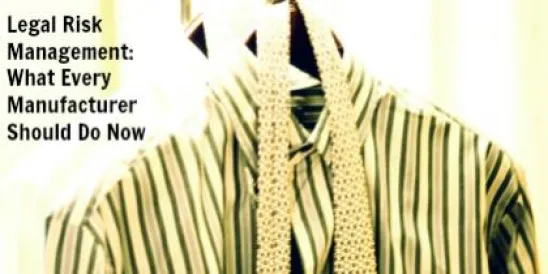“Hope for the best, prepare for the worst.”
The English proverb resonates, particularly in the area of risk management. One of the most important tools available to any successful business operation is the deliberate assessment and tackling of potential risks. However, too often, we see companies underestimate the value of this preparation, only to end up in costly, protracted litigation. Read on to see what every manufacturer can, and should, do to implement appropriate protections and guard against legal problems before they arise.
Regularly Reevaluate Whether the Company’s Insurance Program Meets Its Needs
An obvious starting point in any discussion of effective risk management is insurance. We recommend that companies regularly review their existing insurance program, with an eye toward the past (to assess the most prevalent source of claims) and toward the future (to assess potential future exposures based on planned growth, new product lines, and legal developments).
A periodic and comprehensive insurance audit, conducted with assistance of experienced coverage counsel, should result in a more effective renewal process and an insurance program more carefully tailored to the company’s needs. For effective discussion with insurance brokers, counsel, or both, consider:
1. Looking back and looking ahead. As an obvious starting point, management should review the company’s recent claims history, including claims based on employee relations issues. Identifying the areas of greatest legal risk will aid in the evaluation of areas of exposure that might have been previously overlooked. At the same time, management should evaluate the contours of the company’s current and expected future operations, including whether – and how and where – the company might plan to expand. An expansion raises insurance and possible indemnity issues, all of which should be considered.
2. International operations. Doing business abroad raises complex insurance issues that no company can afford to overlook. If the company is manufacturing products abroad, management should evaluate the coverage afforded to those operations and, importantly, whether the laws of any country in which the company is doing business impose any additional insurance requirements. Many countries impose such requirements, and the penalties for failing to comply can be quite severe.
3. Named insureds. Management should carefully consider who the company intends to insure under each policy. For example, should subsidiaries be insured under the parent’s policy? What about independent contractors? Are vendors and suppliers properly insured under the terms of the parties’ contracts? A thoughtful review of policy language should ensure that the company has provided the necessary insurance coverage.
4. Duty to defend and retentions. Most general liability policies require the insurer to defend the company against lawsuits. Certain companies that face repeated, high-stakes litigation might prefer to control the defense, and an insurer might be willing to permit that, subject to certain conditions such as defense counsel or a third-party administrator periodically updating an assigned claims adjuster on the status of all litigation, and/or a large self-insured retention for each occurrence.
These questions go beyond the general (and more usual) consideration of the adequacy of policy limits, policy language, trigger issues, exclusions, products completed issues and batch clause issues, and should help guide an effective evaluation of the entire insurance program and whether that program meets the company’s existing and anticipated needs.
Protect and Defend Against Products-Related Risks
In addition to taking steps to reevaluate the scope and adequacy of insurance programs, manufacturers can, and should, be proactive in other ways to mitigate the risks posed by the creative plaintiffs’ bar:
1. Evaluate and assess exposure. Just as proper insurance is a useful tool in protecting the company’s bottom line when faced with products liability litigation, so too is an evaluation of exposure to that litigation in the first instance. Conducted before a lawsuit is filed, such an evaluation can help identify the scope of exposure. More importantly, it can help a company identify where changes can be made to decrease exposure.
Areas of inquiry should include: (a) product design and testing (including design drawings, design changes, testing documents and interviews by counsel of key personnel involved in both); (b) product certifications (i.e., U.L. and others) and the implications thereof; and (c) for existing products, prior incident reports (including informally reported incidents, previous litigation regarding the same product, discussions during risk management or similar committee meetings, etc.).
Because the results of any such evaluation could be a plaintiff’s lawyer’s jackpot in the event of litigation, care should be taken in selecting who will conduct the evaluation, how they will do so, and how and to whom the results will be communicated, to preserve the attorney-client privilege.
2. Instructions and warnings. Manufacturers should consider having a risk manager as well as legal counsel review all instruction manuals, labels, warnings, warranties and the like, and revise them to ensure that they comply with the law of the relevant jurisdictions.
Consider whether anything should be printed in another language, as well as whether anything should be revised in light of developments following the product’s initial release.
Consider whether a warning written for the U.S. market is sufficient for any other market where the product is distributed and used, both in terms of substance and language.
3. Actively – even aggressively – participate in claims investigations. One of the worst things a manufacturer can do from a risk management standpoint is to gain a reputation for “rolling over” on claims through early settlement. Although it takes time, manufacturers can shed themselves of that reputation, which may well make them a less frequent target of the plaintiffs’ bar, thus directly impacting their bottom line.
On receiving notice of an investigation of an incident – whether it is a scene investigation or a lab exam – a manufacturer should evaluate the likely exposure and decide how actively to participate. Over time, becoming a regular presence at investigations (and later, aggressively defending rather than settling lawsuits) may go a long way to convincing the plaintiffs’ bar that the manufacturer will no longer so readily settle claims, and ultimately, prompting them to turn elsewhere.
Of course, one of the keys to effective risk management is to recognize that products liability need not, and should not, be a reactive business. Instead, companies should work with their counsel to evaluate and minimize litigation risks posed by existing products, and as they prepare to bring new products to market.
Review and Rethink Employment Policies and Practices
A high-stakes employment lawsuit can deal a serious blow to a company not only financially, but also to its reputation. That is why smart risk management must include an audit and update of a company’s employee policies and related practices. Often overlooked, these measures can play the deciding role in preventing or, at a minimum, successfully defending against a legal claim that may otherwise become the source of tremendous operational, financial and public relations stressors.
Begin an employment audit with a review of the employee handbook. Though handbooks will differ depending on the culture, needs and locales of a business, every one should contain the following basic policies, consistent with applicable law:
1. At-will employment. An employee handbook should convey the general policy of at-will employment, reflecting that either the employer or the employee may terminate the employment relationship at any time, for any lawful reason, with or without notice.
Note that the National Labor Relations Board (“NLRB”) recently put this policy to the test, questioning whether it might be interpreted as interfering with employees’ rights to discuss and attempt to change their work conditions, including through joining a union.
Thus, the at-will policy should be reviewed by counsel to ensure that it is effective and will not catch unwanted attention from the NLRB.
On a related note, an employee handbook also should contain: (a) a prominent disclaimer that it is not intended and should not be interpreted as creating a contract of employment for any set term; and (b) well-worded disciplinary policies giving management the flexibility to take appropriate corrective action on a case-by-case basis, without being held to a rigid progressive discipline procedure.
2. Equal employment opportunity / non-discrimination. These policies also are a “must-have” for any employee handbook. Just as it is relatively easy to draft these policies correctly, it also is easy to get them wrong, including by failing to include the appropriate protected categories or a mandatory complaint procedure to report any related complaints and concerns.
3. Anti-harassment. Every company dreads a harassment lawsuit and the many ramifications it can have on a business. An effective, compliant anti-harassment policy will help prevent harassment from occurring, and will mitigate its harmful effects through mandatory internal reporting, investigation and remedial action procedures. In federal litigation, a working anti-harassment policy can be the difference between whether the company will be held liable, or whether the suit will be dismissed before it even gets to a trial.
4. Wage and hour. Often boiler-plated or forgotten about altogether, these policies are essential in establishing and enforcing compliant time management and pay practices, and in providing a defense to companies in lawsuits over the payment of wages and benefits. As such claims are frequent contenders for class actions, it is imperative to ensure that the wage and hour policies – including policies as to employee classification, recording of time, overtime and paid time off – are in solid shape.
5. Computers, systems and social media. Rapidly evolving technologies continue to transform how we operate and communicate, including at and about work. Yet, many companies either do not have communications systems policies, have outdated policies that fail to appropriately address modern systems and devices, and the related email, texts and Internet and social media posts and activities.
It is essential to have updated communications systems and, often, social media policies in place, to effectively communicate to employees what they can and cannot do, and what they should expect, relative to privacy and potential disciplinary ramifications when they use company-provided computer communications systems.
In addition to having an effective employee handbook in place, a manufacturer should ensure that the handbook is consistently enforced. Smart policy enforcement begins with management’s commitment and timely distribution and effectively communication of the policies. Well-done training should not be “boring” or “tedious” – it should be informative, insightful and practically helpful in effective recognition and resolution of workplace issues before they turn into legal problems.
Consider and Require Appropriate Restrictive Covenants
Manufacturers also should be proactive about considering and, if when appropriate, requiring employees to sign restrictive covenant agreements to protect the business’s proprietary information, products, customers and employees from the competition. In doing so, it is important to keep in mind that restrictive covenant law is constantly evolving, and can vary significantly state-to-state. A restriction that is certain to be upheld in one state may be deemed as patently overbroad and unlawful in another.
In Illinois, for example, restrictive covenants have been routinely enforced so long as they have been appropriately tailored in time and scope, and based on a legitimate business interest.
Just recently, however, in Fifield v. Premier Dealer Services, one Illinois appellate court held that a restrictive covenant will be enforced only if supported by a minimum of two years of continued employment as consideration – an offer of employment or employment lasting less than two years will not suffice.
Even more surprisingly, the Illinois Supreme Court has, at least for now, declined to review that controversial decision.
Thus, crafting an appropriate and an enforceable restrictive covenant is a fine art, and should be done by experienced, competent counsel who are both familiar with the applicable law, and willing take the time needed to understand the company’s business and the protections required to protect it.
And In Conclusion…
Remember, smart risk management is proactive risk management. Every manufacturer can, and should, take steps now to ensure its business is protected through effective insurance coverage, employment policies and practices and related agreements.





 />i
/>i

